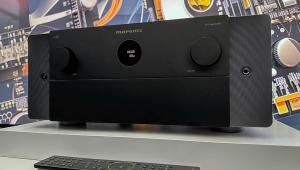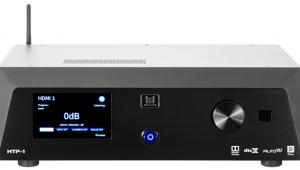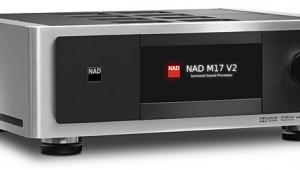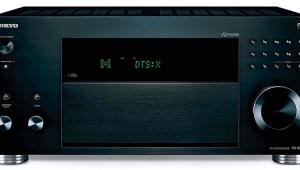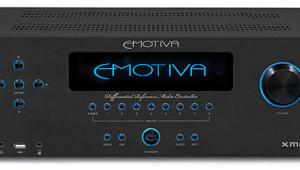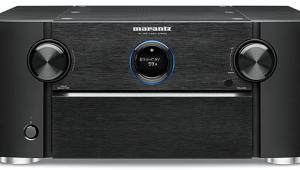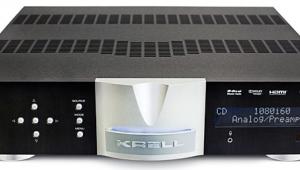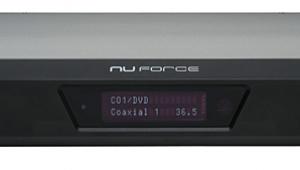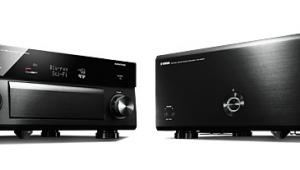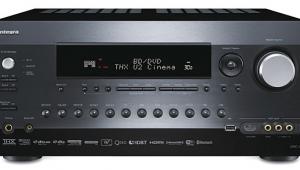Cary Audio Design Cinema 12 Surround Processor & Model 7.125 Multichannel Amplifier HT Labs Measures
Cary Audio Design Cinema 12 surround processor
Analog frequency response in Bypass mode:
–0.04 dB at 10 Hz
–0.00 dB at 20 Hz
–0.07 dB at 20 kHz
–0.44 dB at 50 kHz.
Analog frequency response with signal processing:
–0.20 dB at 10 Hz
–0.05 dB at 20 Hz
–0.02 dB at 20 kHz
–13.33 dB at 50 kHz.
The chart below shows the frequency response of the left (aqua), center (green), LFE (blue), and left surround (purple) channels at the preamp outputs of the Dolby Digital decoder. The left channel measures –0.00 decibels at 20 hertz and +0.05 dB at 20 kilohertz. The center channel measures –0.00 dB at 20 Hz and +0.05 dB at 20 kHz, and the left surround channel measures –0.00 dB at 20 Hz and +0.06 dB at 20 kHz. The LFE channel, normalized to the level at 40 Hz, is +0.02 dB at 20 Hz, reaches the upper –3dB point at 110 Hz, and reaches the upper –6dB point at 118 Hz.
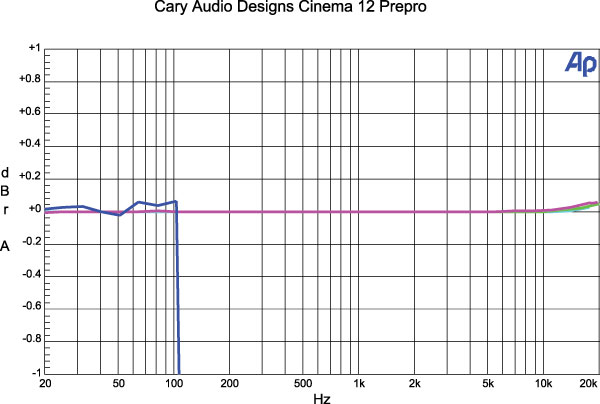
Response from the multi- channel input to the main output measures –0.04 dB at 10 Hz, –0.00 dB at 20 Hz, +0.00 dB at 20 kHz, and +0.01 dB at 50 kHz. The analog THD+N is less than 0.025 percent at 1 kHz with a 100-millivolt input and the volume control set to -6. Crosstalk with a 100-mV input was –93.41 dB left to right and –92.41 dB right to left. The signal-to-noise ratio with “A” weighting was –121.03 dBrA. —MJP
Cary Audio Design model 7.125 multichannel Amplifier
Seven channels driven continuously into 8-ohm loads:
0.1% distortion at 126.6 watts
1% distortion at 139.3 watts
Five channels driven continuously into 8-ohm loads:
0.1% distortion at 130.2 watts
1% distortion at 148.5 watts
Frequency response RCA input:
–0.16 dB at 10 Hz
–0.04 dB at 20 Hz
–0.49 dB at 20 kHz
–4.98 dB at 50 kHz
Frequency response XLR input:
–0.16 dB at 10 Hz
–0.04 dB at 20 Hz
–0.57 dB at 20 kHz
–5.07 dB at 50 kHz.

This graph shows that the 7.125’s left amplifier channel, with two channels driving 8-ohm loads, reaches 0.1 percent distortion at 138.8 watts and 1 percent distortion at 158.6 watts. Into 4 ohms, the amplifier reaches 0.1 percent distortion at 281.9 watts and 1 percent distortion at 313.1 watts. An input level of 58.3 millivolts was required to produce an output of 2.83 volts into an 8-ohm load, indicating an overall gain of +33.75 decibels using the RCA input. When using the XLR input, a level of 58.2 millivolts was required to produce an output of 2.83 volts into an 8-ohm load, indicating an overall gain of +33.78 decibels.
THD+N from the amplifier was less than 0.010 percent at 1 kHz when driving 2.83 volts into an 8-ohm load using the RCA input. When using the XLR input under the same conditions, THD+N was less than 0.011 percent. Crosstalk at 1 kHz driving 2.83 volts into an 8-ohm load was –87.30 dB left to right and –97.70 dB right to left using the RCA inputs and –94.11 dB left to right and –92.99 dB right to left using the XLR inputs. The signal-to-noise ratio with an 8-ohm load from 10 Hz to 24 kHz with “A” weighting was –102.54 dBrA using the RCA input and –102.50 using the XLR input. —MJP
Video Test Bench
The Cary Cinema 12 offers video switching from input to output, but does not do any video processing, leaving that chore to your source or display. The only relevant tests here are Video Clipping (does it pass white and below black), and Luma and Chroma Resolution, all performed here with a 1080p input to a 1080p output. And since it is rated to pass through a 3D source to the display, we tested for that as well. It passed all of these hurdles with no issues. —TJN

